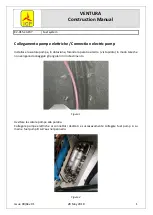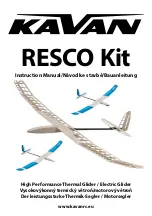
ICE AND RAIN PROTECTION
A. General
Material contained herein provides information for general maintenance characteristic of ice protection
system. If further information is necessary contact product manufacturer or Piper Service
Representative.
B. Description and Operation
Ice protection system is made up of five separate systems: a pneumatic deice system, an electrical prop
deice system, an electrically heated windshield panel, heated pitot/stall warning system, and an ice
detection light installation. These systems can be installed individually or in any combination. Except
for heated pitot/stall warning system, systems are controlled from a control panel on center instrument
panel.
The pneumatic system, which utilizes boots to displace ice from leading edges of flight surfaces,
requires installation of a second, high capacity, air pump. Along with boots and related plumbing,
system also includes a pressure control valve, a vacuum regulator, three deice flow valves, three pressure
switches and a timer module. Pressure control valve is mounted on firewall, and vacuum regulator is
located in forward baggage compartment. Deice flow valves, pressure switches and timer module are
mounted under floor on right side of fuselage as shown in Figure 1.
Boots are attached to leading edge of wings, vertical stabilizer and stabilator. Boots are of a fabric
neoprene is cured to each boot surface to dissipate static electric charges and prevent damage to boots
from those charges, as well as preventing a fire hazard after each flight. Attached to flight surface with
cement, boots are connected to the plumbing, through skin, by flexible and/or aluminum air
connections.
Operation of pneumatic deice system is controlled by a momentary single pole, single throw switch on
control panel (refer to Figure 3). During normal operation, vacuum provided continuously from pump
inlet is directed to boots system through deice flow valves to hold boots down in flight. The pressure
control valve which is closed during normal operation (boots deflated) allows air pressure from pump
to be dumped overboard. Activation of momentary switch activates timer in timer module, which starts
its 18 second cycle, that activates pressure control valve and three deice flow valves in following
sequence: 6 seconds for inboard wing boots, 6 seconds for outboard wing boots, and 6 seconds for tail
boots. Having activated switch, timer is activated to start first 6 second cycle. Pressure begins to build
up in system and upon reaching 8 psi, a pressure switch on deice flow valve illuminates a green
indicator light on control panel. Pressure continues to build (max. pressure 18 psi) until 6 second cycle
is completed. At this point power is removed from deice flow valve and next group of boots is activated.
After three 6 second sequences are completed, pressure control valve is closed and system pressure is
dumped overboard. As pressure decreases, pressure switch on control valve is deactivated, extinguish-
ing green light. With pressure dumped from system, deice valves again direct vacuum to boots. System
now can be reactivated, if necessary, through momentary switch on control panel. System should not
be operated more than once each 60 seconds to obtain maximum service life.
PIPER AIRCRAFT
PA-32R-301/301T
MAINTENANCE MANUAL
30-00-00
Page 30-1
Reissued: July 1, 1993
2G19
Summary of Contents for PA-32R-301T SARATOGA S
Page 26: ...CHAPTER 4 AIRWORTHINESS LIMITATIONS 1C1 ...
Page 29: ...CHAPTER 5 TIME LIMITS MAINTENANCE CHECKS 1C4 ...
Page 53: ...CHAPTER 6 DIMENSIONS AND AREAS 1D6 ...
Page 64: ...CHAPTER 7 LIFTING AND SHORING 1D21 ...
Page 68: ...CHAPTER 8 LEVELING AND WEIGHING 1E1 ...
Page 72: ...CHAPTER 9 TOWING AND TAXIING 1E5 ...
Page 76: ...CHAPTER 10 PARKING AND MOORING 1E9 ...
Page 80: ...CHAPTER 11 REQUIRED PLACARDS 1E13 ...
Page 92: ...CHAPTER 12 SERVICING 1F1 ...
Page 126: ...CHAPTER 20 STANDARD PRACTICES AIRFRAME 1G17 ...
Page 127: ...THIS PAGE INTENTIONALLY LEFT BLANK ...
Page 139: ...CHAPTER 21 ENVIRONMENTAL SYSTEMS 1H5 ...
Page 188: ...CHAPTER 22 AUTOFLIGHT 1J7 ...
Page 193: ...CHAPTER 23 COMMUNICATIONS 1J12 ...
Page 203: ...CHAPTER 24 ELECTRICAL POWER 1J22 ...
Page 263: ...CHAPTER 25 EQUIPMENT FURNISHINGS 2A13 ...
Page 269: ...CHAPTER 27 FLIGHT CONTROLS 2A20 ...
Page 332: ...CHAPTER 28 FUEL 2D11 ...
Page 363: ...CHAPTER 29 HYDRAULIC POWER 2E18 ...
Page 404: ...CHAPTER 30 ICE AND RAIN PROTECTION 2G16 ...
Page 470: ...CHAPTER 32 LANDING GEAR 3A13 ...
Page 550: ...CHAPTER 33 LIGHTS 3D24 ...
Page 562: ...CHAPTER 34 NAVIGATION AND PITOT STATIC 3E12 ...
Page 582: ...CHAPTER 35 OXYGEN 3F8 ...
Page 604: ...CHAPTER 37 VACUUM 3G6 ...
Page 616: ...CHAPTER 39 3G18 ELECTRIC ELECTRONIC PANELS MULTIPURPOSE PARTS ...
Page 620: ...CHAPTER 51 STRUCTURES 3G22 ...
Page 636: ...CHAPTER 52 DOORS 3H14 ...
Page 650: ...CHAPTER 55 STABILIZERS 3I4 ...
Page 662: ...CHAPTER 56 WINDOWS 3I16 ...
Page 670: ...CHAPTER 57 WINGS 3I24 ...
Page 688: ...CHAPTER 61 PROPELLER 3J18 ...
Page 704: ...CHAPTER 70 STANDARD PRACTICES ENGINES 3K10 ...
Page 708: ...CHAPTER 71 POWER PLANT 3K14 ...
Page 737: ...CHAPTER 73 ENGINE FUEL SYSTEM 4A13 ...
Page 749: ...CHAPTER 74 IGNITION 4B1 ...
Page 783: ...CHAPTER 77 ENGINE INDICATING 4C11 ...
Page 793: ...CHAPTER 78 EXHAUST 4C21 ...
Page 801: ...CHAPTER 79 OIL 4D5 ...
Page 805: ...CHAPTER 80 STARTING 4D9 ...
Page 819: ...CHAPTER 81 TURBINES 4D23 ...
Page 833: ...CHAPTER 91 CHARTS WIRING DIAGRAMS 4E13 ...
















































